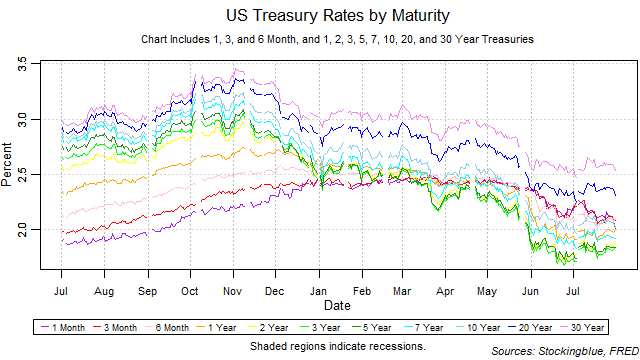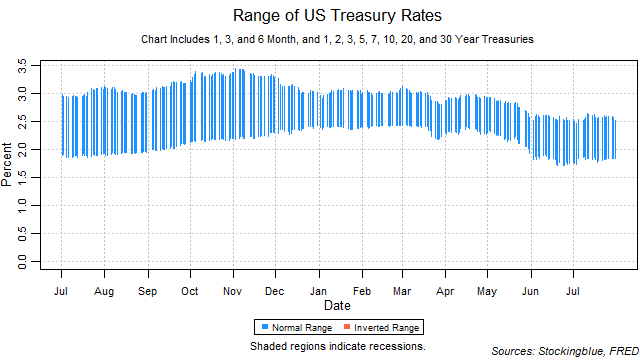
All rates except for the one and three-month bills rose in July. The yield curve narrowed from the previous month thus ending its one month widening streak. The one-month bill did not maintain the lowest rate at any point in the month. Long-term rates rose at an equal or faster pace than short-term rates thus decreasing the risk of an inversion brought upon by rising short-term rates. Such an inversion, if it were to happen would be a strong indicator for an upcoming recession. A side note: several financial analysts have recently pointed to inversions between particular rates like the three-year note having a higher rate than the five-year note as being indicators for a recession. The data does not back this up. The only type of inversion that has led to a recession reliably is one in which the highest rate is a shorter-term treasury than the lowest rate. This is the only inversion that has predicted a recession seven out of eight times since 1962. According to this measure, there is no recession in the foreseeable future.
Findings
- All rates except for the one and three-month bills rose in July.
- The two-year note saw the largest absolute rise at 0.14 points.
- On a relative basis, the two-year note rose the most with a 8.00 percent gain.
- The one-month bill saw the largest absolute drop at 0.17 points.
- On a relative basis, the one-month bill dropped the most with a 7.80 percent drop.
- The one-month bill did not maintain the lowest rate throughout the month or at any point in the month.
- The three-year note held the lowest rate throughout the month and tied for lowest with the five-year note on two occasions.
- The yield curve fell 0.08 points to 0.69.
Caveats
- As always, past performance is not indicative of future results.
- All figures are rounded to the nearest hundredth.
Details

The breadth of the yield curve narrowed 0.08 points over the month to a range of 0.69. The widest range was 0.80 (0.03 points lower than the previous month's widest range of 0.83) which was hit on July 11 and July 12 and the narrowest was 0.66 (0.04 points higher than the previous month's narrowest range of 0.70) which was hit on July 9. The last time the yield curve was this narrow was on May 31, 2019 when it hit a range of 0.65.

The thirty-year bond held the highest rate throughout the month. It has managed to stay above 2.50 percent throughout the month except for one session on July 3. It should be noted that all other rates remained below the 2.50 percent threshold throughout the month. The last time the 30-year rate hit this month's low of 2.47 was on October 7, 2016 when it was at 2.47.

The one-month bill did not hold the lowest rate for any session of the month. The three-year note held the lowest rate throughout the month and tied for lowest with the five-year note on two occasions: July 9 and July 31. The one-month did not hit a new 12-month high extending its streak of no new 12-month highs to four months. The last time the three-year note held the lowest rate prior to this month was on July 31, 2019.
Sources
"Treasury Constant Maturity," Federal Reserve Bank of St. Louis, accessed August 6, 2019, https://fred.stlouisfed.org/categories/115.